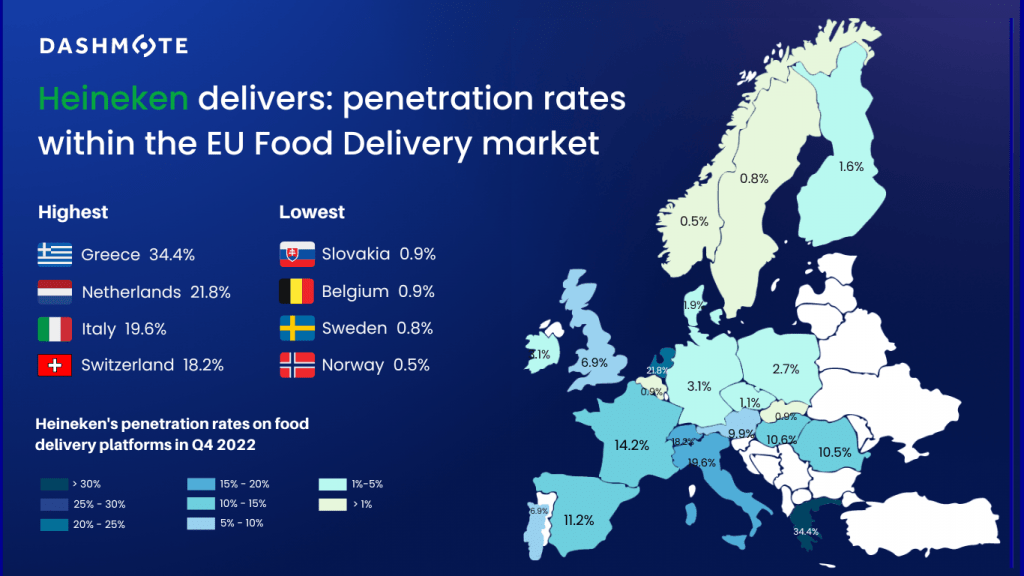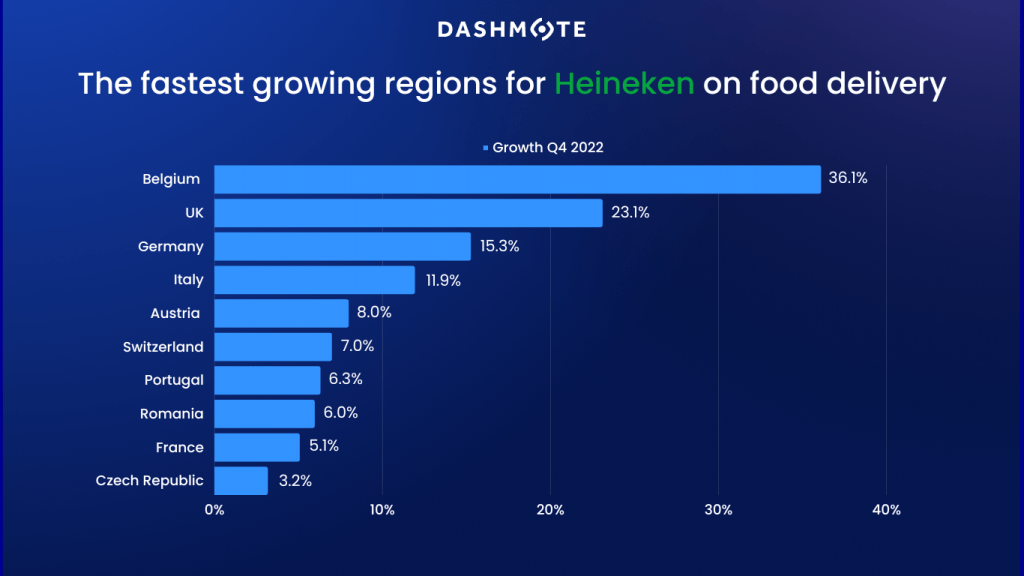The food delivery sector is revolutionising the food and beverage (F&B) industry, even impacting renowned brewers like Heineken. Founded in 1864, Heineken, a Dutch beer company, originated when a 22-year-old named Gerard Adriaan Heineken acquired a brewery in Amsterdam. Presently, it stands as one of the globe's most prominent and easily recognizable beer brands, with its products distributed in more than 170 countries. As a leading brewing group with the second largest production volume worldwide [1], it is bolstering its performance and experiencing increased popularity from leveraging the food delivery platforms.
The beer market in Southeast Asia amounts to US$23.63bn in 2023. The market is expected to grow annually by 6.74% (CAGR 2023-2027) [2]. The area exhibits a growing inclination among consumers for alcoholic drinks, alongside a rising desire for low-alcohol and non-alcoholic beers. Heineken's strategic move into the food delivery sector with its original and non-alcoholic products aligns with these trends, showcasing their forward-looking strategy to remain relevant and easily reachable in the swiftly changing environment.
In this article, we conduct a Heineken Southeast Asian case study. By leveraging Dashmote’s Data Analytics SaaS platform, we analysed Heineken’s presence and growth on food delivery platforms throughout 7 key markets.
Heineken can be found on various food delivery platforms in Southeast Asia, including Gojek, Grab, Lineman, and many more. The specific Heineken beer options available may vary depending on the restaurants and stores, but they typically include Heineken Lager, Heineken 0.0 Non-Alcoholic, and Heineken Silver.
According to Dashmote's data, Heineken has a food delivery beer presence exceeding 30% in 3 out of 7 countries in the current analysis. Notably, Heineken holds a strong position on Vietnamese food delivery platforms, where 64.1% of digital storefronts which sell beers also feature Heineken products. The Philippines ranks second, with a 35.5% beer penetration rate, meaning that 1 in 3 beer-selling restaurants on food delivery platforms offers Heineken. Singapore follows closely with a penetration rate of 31.1%. It's worth mentioning that Heineken's presence in Indonesia (11.2%) and Thailand (8.1%) remains relatively low due to distinct drinking customs and alcohol consumption regulations in these regions.
Since the above analysis pertains to digital storefronts specifically selling beers rather than encompassing all digital storefronts on the platforms, it's essential to recognize that the beer market presence in Southeast Asia remains relatively limited on food delivery, ranging from 0.71% in Indonesia to 11.3% in Singapore. In contrast, when compared to Europe, where 9 countries have a Heineken presence exceeding 10% across all digital storefronts in the respective nation, Heineken still has room for gradual expansion to attain a more substantial foothold in the Southeast Asian market.
Based on Dashmote’s data, a majority of countries have witnessed a noteworthy growth in Heineken’s digital storefront listings on food delivery platforms spanning from Q4 2022 to Q3 2023. Indonesia experienced the largest increase of 25.1%. Following closely is Malaysia, exhibiting a remarkable growth of 24.0%, and Philippines with a commendable 18.7% expansion. Vietnam, although with the largest digital storefront base for Heineken, demonstrated the lowest positive growth of 0.9% over the past three quarters. Conversely, Thailand (-44.7%) encountered substantial declines in Heineken's digital storefront listings, which stands out as an intriguing exception among this trend of growth.
Upon scrutinising the data, it becomes apparent that the decline in the number of digital storefronts offering Heineken in Thailand is predominantly attributable to external factors rather than inherent issues with the brand itself. For example, the reduction of over 400 stores of Mini Big C, a convenience store in Thailand, on food delivery platforms during the timeframe under examination directly impacted the decrease in digital storefronts selling Heineken. This highlights that Heineken's performance in food delivery is significantly influenced by the broader market conditions and underlying macroeconomic variables.
In Southeast Asia, consumers who prioritise their health are actively looking for beer alternatives that offer reduced alcohol content or are entirely alcohol-free. The Non-Alcoholic Beer market in Southeast Asia is currently valued at US$1.91 billion in 2023, and it is projected to experience an annual growth rate of 8.84% (CAGR 2023-2027) [3]. In the midst of this expanding trend, Heineken 0.0 emerges as an ideal choice for those pursuing wellness and healthier living.
Dashmote's data reveals the promising early stages of Heineken 0.0's presence on Southeast Asian food delivery platforms. While it has already established itself in several countries, it has yet to make inroads into markets like Indonesia and Cambodia.
In Vietnam, Heineken 0.0 enjoys the most substantial digital presence, with 17.9% of digital storefronts selling beer offering this product. This achievement follows an impressive 60.1% digital growth from Q4 2022 to Q3 2023. Similarly, Singapore has seen a noteworthy increase of 79.7% in digital storefront listings for Heineken 0.0, resulting in a beer penetration rate of 7.2% in Q3 2023. In Malaysia, Heineken 0.0 also experienced a notable rise of 40.3% in digital storefront listings, even though its beer penetration rate remains relatively modest at 2.5%.
Dashmote is dedicated to assisting enterprises in overcoming obstacles and achieving success in the digital market. As the foremost provider of big data and AI analytics solutions in the food and beverage (F&B) sector, we enable brands to make informed strategic choices by offering thorough analysis and invaluable insights into the food delivery market and F&B trends. Interested in taking your online business to the next level? Please reach out to our team at contact@dashmote.com.
If you find this article valuable, you may wish to check out more of our blog articles on other beer brands, such as Carlsberg and Heineken in Europe.
Food delivery is taking the food and beverage (F&B) industry to new heights, that includes brewers. Heineken is a Dutch beer brand founded in 1864 when 22-year-old Gerard Adriaan Heineken purchased a brewery in Amsterdam. Today, it is one of the world’s largest and most recognizable beer brands, with its products sold in over 170 countries. As the No. 1 brewer in Europe [1], it is ramping up their results and furtherly gaining popularity thanks to delivery platforms.
Food delivery can transform the beer industry in a number of ways. Primarily, it helps the brands to expand their consumer base. It provides greater convenience and availability for consumers, allowing them to enjoy their favourite brews without the need to visit a store. In addition, it increases sales by giving the opportunity to combine drinks with food items into a combo deal.
Heineken's revenue amounted to approximately 27 billion euros in 2021 [1]. As an iconic beer brand worldwide, it is leveraging the food delivery platforms to compete in the formidable US$610 billion beer market [2]. In this article, we conduct a Heineken European case study. By leveraging Dashmote’s Data Analytics SaaS platform, we analysed the presence and growth of the brand on food delivery platforms around Europe.

Heineken is available on a variety of food delivery platforms globally, such as Just Eat Takeaway, Uber Eats, and Deliveroo. The selection of Heineken beers offered varies depending on the restaurants and stores but generally includes Heineken Lager, Heineken 0.0 Non-Alcoholic, and Heineken Silver.
According to Dashmote’s data, surprisingly, Heineken, as a Dutch beer, does not have the highest penetration rate on Dutch delivery platforms. Remarkably, it is the most prevalent in Greece - up to 34.4% of all the digital storefronts (DSFs) in Greece sell Heineken beer. The Netherlands takes second place, with a Heineken penetration rate of 21.8%. This indicates that 1 in 5 of all DSFs on Dutch food delivery sells Heineken beer. This is followed closely by Italy (19.6%) and Switzerland (18.2%). As shown in the graph, 9 countries in Europe have a Heineken penetration rate above 10%, with a particularly strong presence in the south of Europe.
Besides its unique flavour profile and commitment to brewing quality beers, the brand is also known for its sponsorship of sporting events, including the UEFA Champions League and the Formula 1 Grand Prix. These marketing efforts further help the brand to raise awareness and boost its popularity even more in Europe. It is reasonable to believe that Heineken will keep conquering European food delivery. Compared to Coca-Cola, which has an average penetration rate of 50%, Heineken still has plenty of room and opportunities to grow in the European food delivery industry.

According to Dashmote’s data, most of the countries saw positive Q4 growth in DSFs listings of the brand. Belgium experienced the largest increase of 36.1%, yet its DSFs base for Heineken remained relatively small at 181 by the end of 2022. This is followed by the UK with a 23.1% growth and Germany with a 15.3% growth. Interestingly, Greece, with the highest penetration rate of 34.4%, was the only European country that saw a negative decrease in DSFs listings of 8.4% in Q4, 2022.
Dolf van den Brink, Heineken’s Chief Executive, said in a statement in October 2022 that they have seen signs of a slowdown in demand for its beer in some European markets after its third-quarter sales rose by less than expected [3]. This could be caused by the limited consumer purchasing power and beer consumption due to inflation. However, according to Dashmote’s data, we do see a fairly higher growth in some of its major markets, such as the UK and Germany. On a positive note, in the brand's 2023 forecast in August, they expected its operating profit would rise by a mid to high single-digit percentage [4].
In January 2021, Heineken 0.0 launched a global campaign, "Cheers with no alcohol. Now you can", to tap into "Dry January" and the growing market for non-alcoholic drinks at social events. The non-alcoholic beer market amounts to US$36.75 billion in 2023 and is growing annually by 12.61% (CAGR 2023-2025) [5]. Heineken is a key player in this emerging market and shows strong ambition in growing non-alcoholic beers. In fact, 7% of total volume is low or non-alcohol, which is higher than the world’s largest brewer AB InBev (6%).
According to Dashmote’s latest data, the UK has the highest Heineken 0.0 penetration rate of 3.62%. Since the penetration rate of Heineken is 6.9% in total, it indicates that more than half of the DSFs on British food delivery platforms also sell the non-alcoholic version of the beer. This is followed by the Netherlands with a Heineken 0.0 penetration rate of 2.81%, taking up to 1/10 of all the DSFs selling the brand's products. Greece (2.7%), Romania (1.3%), Spain (1.2%), and Ireland (1.1%) all had a Heineken 0.0 penetration rate above 1%.
Dashmote is the leading big data and AI analytics company in the food & beverage industry. We help F&B enterprises by empowering leaders and analysts to track and analyse publicly available data to contribute to making strategic decisions for your brand. Do you want to know more about retrieving market insights across food delivery and F&B?
→ Please contact sales@dashmote.com.